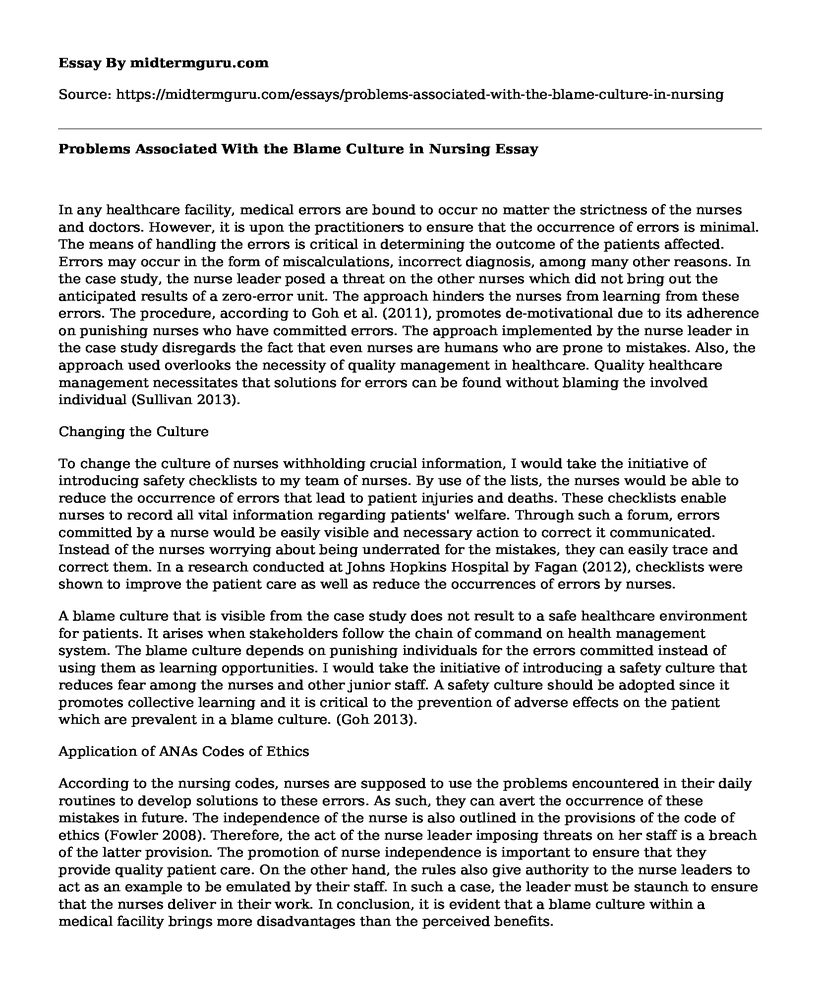In any healthcare facility, medical errors are bound to occur no matter the strictness of the nurses and doctors. However, it is upon the practitioners to ensure that the occurrence of errors is minimal. The means of handling the errors is critical in determining the outcome of the patients affected. Errors may occur in the form of miscalculations, incorrect diagnosis, among many other reasons. In the case study, the nurse leader posed a threat on the other nurses which did not bring out the anticipated results of a zero-error unit. The approach hinders the nurses from learning from these errors. The procedure, according to Goh et al. (2011), promotes de-motivational due to its adherence on punishing nurses who have committed errors. The approach implemented by the nurse leader in the case study disregards the fact that even nurses are humans who are prone to mistakes. Also, the approach used overlooks the necessity of quality management in healthcare. Quality healthcare management necessitates that solutions for errors can be found without blaming the involved individual (Sullivan 2013).
Changing the Culture
To change the culture of nurses withholding crucial information, I would take the initiative of introducing safety checklists to my team of nurses. By use of the lists, the nurses would be able to reduce the occurrence of errors that lead to patient injuries and deaths. These checklists enable nurses to record all vital information regarding patients' welfare. Through such a forum, errors committed by a nurse would be easily visible and necessary action to correct it communicated. Instead of the nurses worrying about being underrated for the mistakes, they can easily trace and correct them. In a research conducted at Johns Hopkins Hospital by Fagan (2012), checklists were shown to improve the patient care as well as reduce the occurrences of errors by nurses.
A blame culture that is visible from the case study does not result to a safe healthcare environment for patients. It arises when stakeholders follow the chain of command on health management system. The blame culture depends on punishing individuals for the errors committed instead of using them as learning opportunities. I would take the initiative of introducing a safety culture that reduces fear among the nurses and other junior staff. A safety culture should be adopted since it promotes collective learning and it is critical to the prevention of adverse effects on the patient which are prevalent in a blame culture. (Goh 2013).
Application of ANAs Codes of Ethics
According to the nursing codes, nurses are supposed to use the problems encountered in their daily routines to develop solutions to these errors. As such, they can avert the occurrence of these mistakes in future. The independence of the nurse is also outlined in the provisions of the code of ethics (Fowler 2008). Therefore, the act of the nurse leader imposing threats on her staff is a breach of the latter provision. The promotion of nurse independence is important to ensure that they provide quality patient care. On the other hand, the rules also give authority to the nurse leaders to act as an example to be emulated by their staff. In such a case, the leader must be staunch to ensure that the nurses deliver in their work. In conclusion, it is evident that a blame culture within a medical facility brings more disadvantages than the perceived benefits.
References
Fagan, M. J. (2012). Techniques to improve patient safety in hospitals: what nurse administratorsneed to know. Journal of Nursing Administration, 42(9), 426-430.
Fowler, M. D. M. (2008). Guide to the code of ethics for nurses: Interpretation and application.Nursesbooks. org.
Goh, S. C., Chan, C., & Kuziemsky, C. (2013). Teamwork, organizational learning, patientsafety and job outcomes. International journal of health care quality assurance, 26(5),420-432.
Sullivan, E. J. (2013). Effective leadership and management in nursing. (8th ed.). Upper SaddleRiver: Pearson Prentice Hall.
Cite this page
Problems Associated With the Blame Culture in Nursing. (2021, May 28). Retrieved from https://midtermguru.com/essays/problems-associated-with-the-blame-culture-in-nursing
If you are the original author of this essay and no longer wish to have it published on the midtermguru.com website, please click below to request its removal:
- Essay on Personal Health Assessment
- Sign Language Interpreting and Text Alternatives for Deaf Students - Assignment Example
- Sleep Deprivation: Research Proposal
- Re-Defining Nursing Education: Innovations for Student Engagement - Essay Sample
- 6 Million Americans Affected by Congestive Heart Failure - Essay Sample
- Cultural Diversity: Religion - Essay Sample
- Police-Community Partnership: Exploring the Impact of Cultural Diversity - Essay Sample







